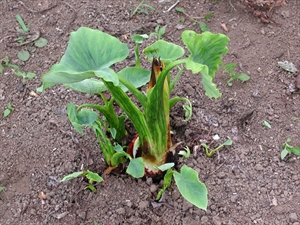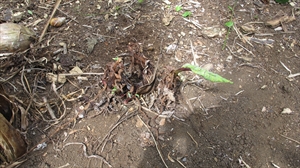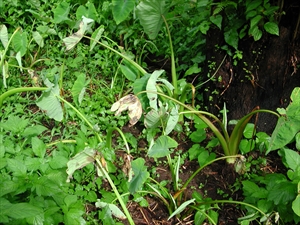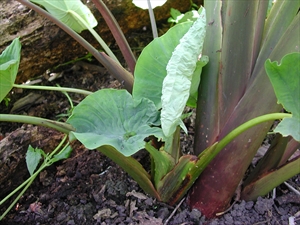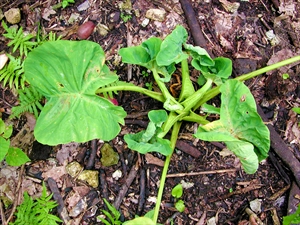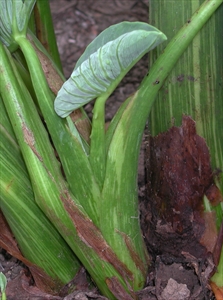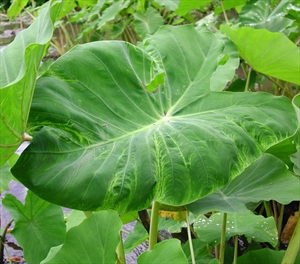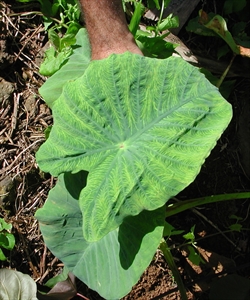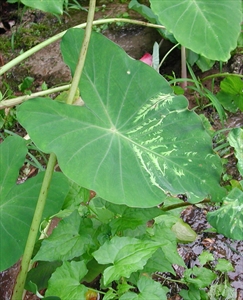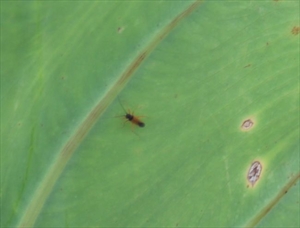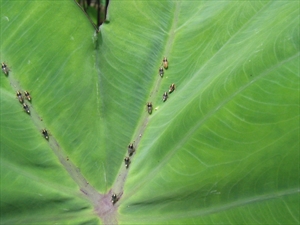Alomae and bobone
Pacific Pests, Pathogens, Weeds & Pesticides - Online edition
Pacific Pests, Pathogens, Weeds & Pesticides
Taro alomae & bobone (001)
Several viruses have been identified in plants with these diseases, but it is not yet certain which ones are the cause. The viruses associated with these diseases are: Colocasia bobone disease rhabdovirus (CBDV); Taro vein chlorosis rhabdovirus (TaVCV); Taro badnvirus (TaBV); Dasheen mosaic potyvirusvirus (DsMV). It recent years, a tenuivirus has been detected, as well as genome sequences of Colocasia bobone disease-associated virus (CBDaV), but it is not yet clear if this is the same as CBDV.
Alomae and bobone occur in Papua New Guinea and Solomon Islands. The distribution of the viruses is as follows: i) Colocasia bobone disease rhabdovirus occurs only in Solomon Islands and Papua New Guinea; ii) Taro vein chlorosis virus is recorded in Fiji, Federated States of Micronesia, New Caledonia, Palau, the Philippines, Samoa, Solomon Islands, and Vanuatu; and Taro badnavirus and Dasheen mosaic virus are present worldwide. The undescribed tenuivirus has been recorded from Papua New Guinea and Solomon Islands.
Note, Taro vein chlorosis virus in Vanuatu is similar to that of Samoa, but differs from that recorded in Fiji. The relationship of Taro vein chlorosis virus elsewhere to these two strains in not known.
Colocasia bobone disease virus and Taro vein chlorosis virus have only been recorded from taro (Colocasia esculenta); Taro badnavirus has been recorded from taro, Xanthosoma sagittifolium (tannier) and Alocasia macrorrhizos (giant taro). Dasheen mosaic virus occurs in all the edible aroids (taro, giant taro, giant swamp taro, Xanthosoma), and in many ornamental aroids.
Plants with alomae show a variety of symptoms. (Photos 1-5&9). The leaves are shorter than normal with distorted leaf blades, but remain green, or they can show stunted young leaves which remain rolled, twisted and pale yellow. Galls may be present on the petioles of the distorted leaves. Soon after the initial symptoms, plants stop producing leaves and gradually die as the plants rot.
Plants with bobone are similar to alomae at first: the leaves remain green, but are stunted, thickened, curled or partly curled, and there are galls, but plants gradually recover (Photos 6-8).
Plants that die from alomae are called 'male' on Malaita, Solomon Islands, and those that are resistant, but show bobone are called 'female' (perhaps 5 or 6 varieties).
Insects spread the viruses that are found in alomae and bobone:
- Colocasia bobone disease rhabdovirus and Taro vein chlorosis rhabdovirus are spread by Tarophagus species: planthoppers.
- A tenuivirus (as yet unnamed) may be spread by Tarophagus species: planthoppers (unproven).
- Taro badnavirus is spread by Planococcus and Pseudococcus species: mealybugs.
- Dasheen mosaic virus is spread by Aphis gosypii and Myzus persicae (experimentally): aphids.
The insects suck up the viruses as they feed on diseased plants, and spread the viruses as they move to healthy plants and feed.
The viruses are also spread in planting material. Often, the viruses do not show symptoms; in this case they are said to be 'latent'. For instance, most plants examined contain Taro badnavirus and Dasheen mosaic virus without showing symptoms, or only rarely showing symptoms. However, the viruses inside the plant pass from mother plants to their suckers.
In the same way, it is likely that all 'female' taro are infected with the Colocasia bobone disease rhabdovirus. Sometimes bobone occurs after planting, when plant hoppers are absent. It is possible that stress at planting allows the virus to multiply and symptoms occur.
Alomae is also spread in planting material. If infection occurs near harvest without causeing symptoms, suckers and stems of mother plants may be used for planting the next crop.
Alomae is a lethal disease that affects nearly all varieties of taro. On Malaita, Solomon Islands, it is very difficult to grow 'male' taro in the lowlands. In recent years, the disease has spread to other islands in Solomon Islands with devastating results, such as the Weather Coasts of Guadalcanal and Makira. It is not unusual for entire gardens to be destroyed by alomae. Farmers want to grow 'male' taro for their size and also there are many varieties so they have a choice of tastes and textures.
Bobone does not kill taro; it reduces the yield by about 25 per cent. Plants usually start to produce healthy leaves after 4-6 weeks, and then appear normal. The disease only occurs in a few varieties of taro. So where alomae exists, farmers have to grow 'female' taro which are lower yielding.
Symptoms of other taro viruses on their own are often mild, and do little damage: see, (i) Taro vein chlorosis virus (Photo 10), (ii) Taro badnavirus (Photo 11), and (iii) Dasheen mosaic virus (Photos 12&13).
It is important to inspect taro gardens regularly. Look at the youngest leaves. If a plant has alomae or bobone, the youngest leaf will be stunted, slightly curled under, and crinkled. Sometimes, the young leaves with alomae are paler than older leaves, but not always so. Usually, the young leaves with bobone are green, thickened and distorted, perhaps with prominent galls on the petioles. However, it is difficult to tell alomae and bobone apart at an early stage.
Later, if plants have alomae, they will stopped producing leaves and start to die, whereas plants with bobone will produce 4-6 distorted leaves, and then leaves which look healthy.
QUARANTINE
Note, that there are many countries in the Pacific vulnerable to these diseases, so where they are not yet present (everywhere except Papua New Guinea and Solomon Islands), biosecurity authorities should be alert to potential pathways for their introduction. If countries want to introduce germplasm for testing, they should follow the FAO/IBPGR Technical Guidelines for the Safe Movement of Edible Aroid Germplasm (http://www.bioversityinternational.org/e-library/publications/detail/edible-aroid/). This stipulates that introductions should be as virus-tested plants growing in tissue culture.
BIOLOGICAL CONTROL
Cyrtorhinus fulvus, a bug that feeds on the eggs of Tarophagus species (Photo 14), reduces the population of the plant hopper, but experience shows that it is not enough to stop the spread of alomae when Tarophagus populations are high (Photos 15&16).
CULTURAL CONTROL
Alomae is best controlled by cultural methods. It is very important that farmers:
- Know that insects spread alomae; they spread the disease between plants and between gardens.
- Form a village group of taro growers, which meets regularly, exchanges ideas, and where members help each other.
- Agree to apply control measures over a wide area, with each farmer doing the same in his or her garden.
Farmers should do the following:
Before planting:
- Make new gardens as far away from previous gardens as possible.
- Avoid taking planting material from diseased to new gardens.
- Plant resistant varieties: 'female' taro are resistant to alomae, and they can be used where the disease is severe, especially in the lowlands.
- Do not plant 'male' and 'female' taro together.
During growth:
- Pull out alomae plants carefully, making sure that any planthoppers are trapped in the leaves or between the stalks; alternatively, put a (e.g., rice) bag over the diseased plants before pulling them out and burning them.
- Do not pull out plants and leave them in the garden or throw them into the bush - the insects will fly or jump back again.
After harvest:
- Collect all debris after harvest and burn or bury it.
CHEMICAL CONTROL
Regular spraying with a synthetic pyrethroid insecticides will kill Tarophagus and reduce alomae. It will not prevent bobone as plants are already infected.
____________________
When using a pesticide, always wear protective clothing and follow the instructions on the product label, such as dosage, timing of application, and pre-harvest interval. Recommendations will vary with the crop and system of cultivation. Expert advice on the most appropriate pesticide to use should always be sought from local agricultural authorities.
AUTHORS Helen Tsatsia & Grahame Jackson
Information from Lethal taro viruses - still unresolved. (https://www2.pestnet.org/other-pacific-plant-protection-stories/); and Carmichael A, et al. (2008) TaroPest: an illustrated guide to pests and diseases of taro in the South Pacific. ACIAR Monograph No. 132, 76 pp. (https://lrd.spc.int/about-lrd/lrd-project-partners/taropest); and Revill RA, et al. (2005) Incidence and distribution of viruses of Taro (Colocasia esculenta) in Pacific island countries. Australasian Plant Pathology 34: 327-331; and Shaw DE, et al. (1979) Virus diseases of taro (Colocasia esculenta) and Xanthosoma sp. in Papua New Guinea. Papua New Guinea Agricultural Journal 30: 71–97; and from Macanawai AR, et al. (2005) Investigations into the seed and mealybug transmission of the Taro bacilliform virus. Australasian Plant Pathology 34: 73-76. Photo 14 Mike Furlong, University of Queensland, Australia.
Produced with support from the Australian Centre for International Agricultural Research under project PC/2010/090: Strengthening integrated crop management research in the Pacific Islands in support of sustainable intensification of high-value crop production, implemented by the University of Queensland and the Secretariat of the Pacific Community.

